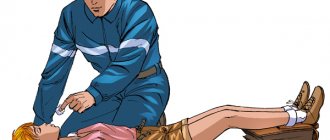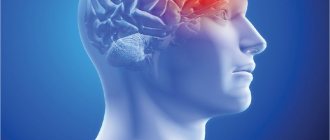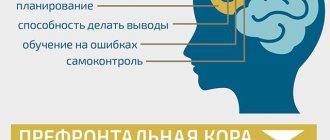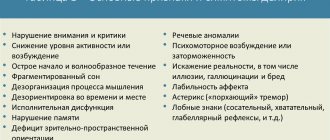The state of stupefaction is a pathological state of the psyche, the symptoms of which include increased emotional sensitivity to all stimuli from the outside world and a simultaneous dulling of higher nervous activity. This phenomenon also occurs under the name “stunned consciousness syndrome.”
Types of disease
There are several stages of this disease:
- Nullification;
- Doubt;
- Sopor;
- Coma.
Numbulation is a mild form of stunned syndrome. This condition implies an unstable state of consciousness. The state of health of a person suffering from numbing is similar to a state of mild intoxication, when the world around him seems to be in a fog, all mental reactions are slow, and the patient’s attention is scattered.
Doubtfulness is a deep stage of the state of stupor and is characterized by minimal physical activity of the patient, absence of facial expressions and any complaints about one’s well-being. A person suffering from somnolence is half asleep, has difficulty perceiving reality and expresses a response only when exposed to very strong stimuli.
Reference! Stupor and coma are severe stages of this syndrome, and are characterized by an almost unconscious state of the patient and, in some cases, leading to death. However, it is important to note that the disease progresses to such stages relatively less frequently.
How does moderate stun differ from deep stun?
Moderate stunning is accompanied by a slowdown in mental activity and a decrease in the ability to actively pay attention. You can communicate with the patient, but his answers to questions are delayed, sometimes the question needs to be repeated or the victim needs to be patted. The patient quickly gets tired, his facial expressions are poor, the patient reacts to pain, and may lose orientation in the area.
With deep stupor, the patient experiences drowsiness, he rarely makes any movements and his mental activity is difficult. Verbal contact with the victim is severely difficult, answers can only be obtained after persistent requests, they are monosyllabic in nature - “yes”, “no”, while the victim is able to provide his information: full name, age. When communicating with him, you need to repeat the same word over and over again. In this case, the victim is able to follow basic commands: open his eyes, show his tongue, etc. The defensive reaction to pain is preserved, but orientation in place and time is absent.
Causes
The causes of stunned consciousness syndrome in humans are circulatory disorders or serious damage to brain structures.
Most often, deafness occurs precisely as a result of severe injuries to the skull. At the same time, symptoms can appear either immediately after the injury or after some time.
Acute cerebrovascular accidents are also a common cause of this syndrome. For example, ischemic stroke, cerebral hemorrhage, transient cerebrovascular accidents, etc.
Among the causes of stunned consciousness, severe bacterial and viral diseases, such as inflammation of the membranes of the brain or liver tissue, can also be identified.
The most common causes also include endogenous or exogenous intoxication of the body, due to an overdose of drugs, sleeping pills, or poisoning with products that contain ethanol.
Attention! According to medical practice, the cause of blackouts in a milder form is alcohol or drug intoxication.
Options for loss of consciousness
The human brain determines the normal functioning of all motor, conscious and sensory functions. The following types of disorders of the central nervous system are distinguished:
- syncope (short-term loss of consciousness - fainting);
- coma (preagonal and agonal state);
- clinical death (absence of all signs of life, when there is very little time left to save a person).
With a minor and short-term disruption of brain functioning, a fainting state occurs; with serious health problems, a coma occurs. Loss of consciousness is a sudden loss of the ability to react to the outside world: a person who is fainting has no signs of vital activity except breathing and heartbeat (as an exception, there are convulsions - chaotic movements of the limbs). If left untreated and in the presence of cardiopulmonary impairment, deep fainting can lead to cessation of heartbeat and loss of respiratory function. Clinical death is the end of the terminal stage of coma, when the loss of conscious functions and irreversible changes in the brain are separated by minutes.
Which doctor treats
After providing urgent medical care and establishing the exact cause that caused the stunned consciousness syndrome, in the first stages of treatment, doctors eliminate the factors that provoked the onset of the disease. When the patient’s condition returns to normal, the treatment and rehabilitation period is supervised by a neurologist.
Kuntsevo Medical and Rehabilitation Center offers the services of leading specialists in the field of neurology. Our own diagnostic facilities allow us to carry out all the necessary examinations, establish a diagnosis and undergo treatment without leaving the clinic.
IMPORTANT! The state of stupefaction is an acute phenomenon that must be urgently eliminated. This cannot be done without consulting an experienced neurologist, so we recommend that you make an appointment with our specialist.
Firstly, the neurologist will immediately determine the reasons for the development of the state of stunned state, because the source of the stunned syndrome can be either a bacterial or viral lesion, or acute cerebrovascular accidents. Secondly, our doctor will choose the most effective tactics for treating and rehabilitating the patient. Sign up for a consultation with a neurologist at the Kuntsevo Medical and Rehabilitation Center and eliminate your state of stupefaction!
Sign up
Qualitative disturbances of consciousness
You are probably already accustomed to this simple classification of pathologies of mental functions in psychiatry. Almost all violations of all functions are divided into quantitative (strengthening and weakening) and qualitative (perversion). Today’s topic will be no exception - qualitative disorders of consciousness are a perverted version of normal consciousness, not reduced quantitatively.
The main qualitative disorders of consciousness are delirium, amentia, twilight stupor and oneiroid.
Delirium
Delirium is a severe disturbance of mental activity, which is expressed in confusion, true hallucinations, illusions, severe psychomotor agitation and disturbance of orientation in place, time and (sometimes) in personality.
Delirium begins with a feeling of anxiety, restlessness and increased sensitivity to light, sounds and other stimuli (hyperesthesia). The patient suffers from insomnia, trying in vain to relax and fall asleep. Then anxiety increases, reaching panic. At the same time, perception disorders appear - first illusions, and then hallucinations. Illusions in this state are closely related to the surrounding environment - the glare of light from street lamps forms ominous human faces, the branches of a house plant become hooked paws, and the patterns on the carpet turn into streams of running insects.
Then mental disorders increase, and hallucinations join the general fun. In the overwhelming majority of cases, these are true frightening hallucinations - patients see rotting impersonal corpses, blood, dead relatives, hostile supernatural beings.
At the peak of delirium, scene-like hallucinations appear, that is, the entire situation changes - patients, while in the hospital, see themselves in a cemetery, in their own crypt, on board a spaceship, in the bowels of another planet, etc. The patient experiences extreme fear or rage, he tries to interact with the hallucinations - to hit them, push them away, or flee. In this state, patients show extraordinary strength, they destroy furniture and overturn heavy objects, they can jump out of a window, without realizing that they are putting their lives at risk.
The patient cannot sleep until the delirium resolves. Typically, the state of delirium lasts 2-4 days, after which the patient falls soundly asleep and, after half a day of deep sleep, wakes up in a normal mental state.
In modern psychiatry, special types of delirium are distinguished:
- Abortive delirium . Such delirium resolves within a few hours, orientation is only partially impaired, and proceeds relatively easily;
- Delirious delirium . The more common term is “muttering delirium.” This type of delirium is characterized by a more profound impairment of consciousness. Here there is chaotic excitement within the bed, indistinct muttering and shouting of individual words or fragments of phrases. There are senseless grasping movements;
- Occupational delirium is a condition similar to ordinary delirium, however, with all other similar symptoms, the patient is convinced that he is at his workplace and performs stereotypical actions related to his work (hammering non-existent nails, signing non-existent contracts, etc.).
A fundamentally important point is that with delirium, orientation in one’s own personality is not disturbed Interaction with hallucinations occurs in accordance with the patient’s temperament - brave and courageous people rush in rage at “demons” or “living dead”, while more cautious people run away in horror or try to hide.
Amentia
Amentia is a clouding of consciousness, very similar to ordinary delirium. However, with amentia, the patient does not leave the bed; periods of excitement alternate with periods of complete rest (amnestic lacunae). His thinking is incoherent, and his speech consists of separate words.
With amentia, orientation in the individual is disrupted. Patients are not available for contact. Also, with amentia, hallucinations, unlike delirium, are scanty and ephemeral. An important feature of amentia is severe physical exhaustion . As a rule, amentia indicates a long-term debilitating disease.
Twilight stupefaction
Twilight stupefaction (twilight state) is a sudden, deep disorientation in the surrounding space while maintaining the usual automatic actions. Here we are talking about a condition when a “failure” in consciousness suddenly occurs and the patient completely ceases to control and feel himself. I remember the story of my propaedeutics teacher about one of his patients.
This was a young woman who, for the first time in her life, experienced an attack of twilight stupefaction. She came home after a long day of work, closed the door behind her and lost consciousness before she had time to take off her coat and hat (it was late autumn). When she woke up, this young woman experienced a chilling horror, because when she opened her eyes, she saw that she was standing in front of the mirror in an evening dress and with bright makeup.
There is a triad of signs characteristic of the twilight state:
- Paroxysmality is a sudden onset and an equally sudden end;
- The behavior of patients is determined by the nature of their experiences;
- Complete amnesia for the entire painful period.
Clinically, two large groups of states of twilight consciousness are distinguished: ambulatory automatism and delusional-hallucinatory (sometimes separately delusional and hallucinatory) twilight consciousness.
Outpatient automatism
Outpatient automatisms are short periods of confusion during which the patient performs habitual, automatic actions. There is no violent behavior or socially dangerous acts here. Being in a state of darkened consciousness, “oblivion,” patients can move around the streets, stop in front of a red traffic light, and briefly answer questions from others. After the end of the attack of twilight consciousness, the patient does not understand how he ended up in this or that place, and does not remember his words and actions at all. I considered a typical example of ambulatory automatism a little higher, when we were talking about a young girl who suddenly found herself in a dress. Outpatient automatisms are classified into fugues, trances and somnambulism.
Fugues (from the Latin “fugas” - “to run”) are sharp, short-term attacks of stupefaction, during which the patient, unexpectedly for those around him, breaks away and rushes to run in bizarre directions, which he himself, after emerging from the attack, cannot explain. The fugue lasts, as a rule, no more than 2-5 minutes.
Trances are states in which the stupefaction of consciousness lasts longer than during fugues. During trance, the patient can leave the house, use public transport, or even leave the boundaries of his city. When the attack passes, the patient finds himself disoriented in an unfamiliar place and has no idea how he got there.
Somnambulism is exactly what our grandparents called “sleepwalking.” Attacks of somnambulism occur during sleep. The patient, in the presence of a minor irritant (the light of the moon or a night lamp), gets out of bed, performs automatic actions - walks, straightens the bed, overcomes obstacles, after which he returns to bed and continues the interrupted sleep. The next morning the patient does not remember anything from the night's incident and listens with surprise to stories about his attack.
There are a number of recommendations for patients suffering from somnambulism - when choosing real estate, choose apartments located on the ground floor, do not store cold and loaded firearms at home, and, if possible, install alarms on the doors.
Treatment methods
First of all, the neurologist refers the patient to a hardware examination of the head and brain (MRI) to exclude the possibility of other diseases and confirm the diagnosis. Then, based on the results of the study, the specialist draws up an individual treatment plan.
Depending on the factors that caused the stunned consciousness syndrome, various therapeutic measures are used, among which are:
- Administration of insulin or glucose (if diabetic coma is suspected);
- Blood purification (in case of impaired consciousness due to uremia);
- Use of agents to stop vomiting and maintain normal breathing/blood flow;
- Surgical intervention by a surgeon/neurosurgeon for hematomas of the meninges/head or neck injuries;
- Administration of an antidote for overdose;
- Antibacterial therapy;
- Tracheal intubation and artificial ventilation in severe cases;
- Administer anticonvulsant medications as needed;
- Injections of thiamine and diuresis catalysts for intoxication.
results
In the case of the initial stages of stunned syndrome, a quick response and immediate examination allows you to find out the cause of the disturbance of consciousness in the shortest possible time. As the necessary measures are taken to eliminate the cause of the disease, the patient gradually returns to normal.
Important! In severe cases, it is difficult to predict the results of treatment. But it is necessary to understand that the longer the patient is unconscious, the less chance of full recovery.
Therefore, if even minor symptoms occur, you should immediately contact a neurologist.
Rehabilitation and lifestyle restoration
After treatment of severe stages of stunned consciousness, it is necessary to remain under the supervision of a doctor for some time to monitor the recovery process, study the current neuralgic status of the patient and conduct linguistic tests.
The Kuntsevo Medical and Rehabilitation Center provides all the necessary conditions for a comfortable recovery for patients. Modern, world-class equipment, as well as the professionalism and many years of experience of the clinic’s doctors, make the rehabilitation process more effective and safe.








